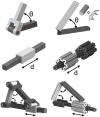Programmable motion of DNA origami mechanisms
- PMID: 25561550
- PMCID: PMC4311804
- DOI: 10.1073/pnas.1408869112
Programmable motion of DNA origami mechanisms
Abstract
DNA origami enables the precise fabrication of nanoscale geometries. We demonstrate an approach to engineer complex and reversible motion of nanoscale DNA origami machine elements. We first design, fabricate, and characterize the mechanical behavior of flexible DNA origami rotational and linear joints that integrate stiff double-stranded DNA components and flexible single-stranded DNA components to constrain motion along a single degree of freedom and demonstrate the ability to tune the flexibility and range of motion. Multiple joints with simple 1D motion were then integrated into higher order mechanisms. One mechanism is a crank-slider that couples rotational and linear motion, and the other is a Bennett linkage that moves between a compacted bundle and an expanded frame configuration with a constrained 3D motion path. Finally, we demonstrate distributed actuation of the linkage using DNA input strands to achieve reversible conformational changes of the entire structure on ∼ minute timescales. Our results demonstrate programmable motion of 2D and 3D DNA origami mechanisms constructed following a macroscopic machine design approach.
Keywords: DNA nanotechnology; DNA origami; dynamic structures; machine design; self-assembly.
Conflict of interest statement
The authors declare no conflict of interest.
Figures






References
-
- Hamdi M, Ferreira A. Multiscale design and modeling of protein-based nanomechanisms for nanorobotics. Int J Robot Res. 2009;28(4):436–449.
-
- Mavroidis C, Dubey A, Yarmush ML. Molecular machines. Annu Rev Biomed Eng. 2004;6(1):363–395. - PubMed
-
- Ummat ADA, Sharma G, Mavroidis C. Bio-nanorobotics: State of the art and future challenges. In: Yarmush ML, editor. The Biomedical Engineering Handbook. CRC Press; Boca Raton, FL: 2006.
Publication types
MeSH terms
Substances
LinkOut - more resources
Full Text Sources
Other Literature Sources
Molecular Biology Databases

